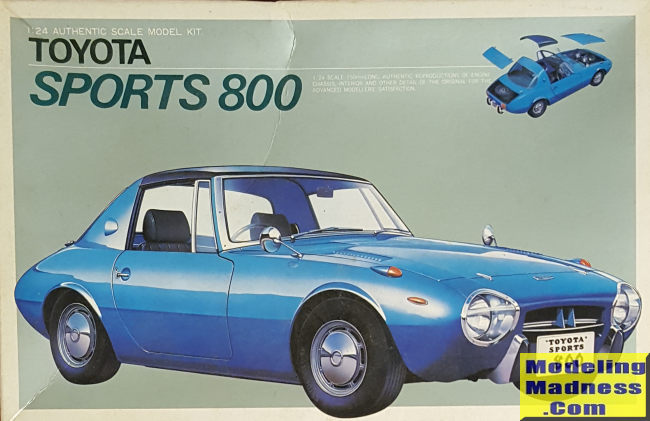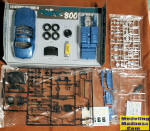
Nitto 1/24 Toyota Sports 800
| KIT #: | 15086 |
| PRICE: | 900 yen SRP. I paid $25.00 |
| DECALS: | One option |
| REVIEWER: | Scott Van Aken |
| NOTES: | S |

| HISTORY |
The Toyota Sports 800 (Japanese: トヨタ・スポーツ800, Toyota Supōtsu Happiyaku) is Toyota's first production sports car. The prototype for the Sports 800, called the Publica Sports, debuted at the 1962 Tokyo Auto Show, featuring a space age sliding canopy and utilizing the 21 kW (28 hp; 29 PS) powertrain of the Publica 700, a Japanese market economy car. The Toyota Sports 800 is affectionately called the "Yota-Hachi" (ヨタハチ), which is a Japanese short form for "Toyota 8". In Japan, the vehicle was exclusive to Toyota Japan retail sales channel called Toyota Publica Store alongside the Publica.
The vast majority of the 3,131 cars were right hand drive, but some 300 were left hand drive models, built primarily for the Okinawa market (Okinawa, having been American occupied, drove on the right side of the road instead of the left like the rest of Japan). A very limited number of left hand drive cars were used by Toyota to "test drive" in the US, but the American dealerships decided the 800 would not sell well in the US and made a decision not to import or sell the cars in the US market. Toyota let these dealers keep the original batch of around 40 Sports 800s in the US instead of having them shipped back to Japan.
There are subtle design differences between the years. Noticeable differences have included: change over from non-synchro to synchro first gear in 1967; a grill and bumperette change in 1968; and side marker lights in 1969. The basic body design, however, remained unchanged.
An air-cooled 790 cc horizontally opposed two-cylinder boxer engine powered the vehicle. The 0.8 liter 2U (45 PS at 5,400 rpm) was produced from 1965 through 1969, while a similar 2U-B was produced from 1966 through 1976 (in 1975 the Dyna Coaster Bus manual shows that Toyota used the 2U-B as a separate auxiliary engine, just to run the air conditioning unit for the bus). In a less tuned form, the 2U was also used in the Publica (UP20/UP26) and MiniAce (UP100).
Weight was kept down by using aluminum on selected body panels and thin steel on the unibody construction. For the first few years of production even the seat frames were made of aluminum.
| THE KIT |
 Back when I had an LHS, this one was on the shelf, having been bought as part
of a collection. I thought it was a quirky design and something instantly
recognizable as 60s/70s Japanese so I bought it. Opening the somewhat shelf worn
box a couple of days ago, I was pleased to see that the kit was in great shape.
The main body, chassis, tires, and glue were all encased together making a neat
display.
Back when I had an LHS, this one was on the shelf, having been bought as part
of a collection. I thought it was a quirky design and something instantly
recognizable as 60s/70s Japanese so I bought it. Opening the somewhat shelf worn
box a couple of days ago, I was pleased to see that the kit was in great shape.
The main body, chassis, tires, and glue were all encased together making a neat
display.
The kit was originally released in 1980 and this is one of those releases. It was again released with a clear body and in 1985, the last release had slightly modified box art. The body is molded in blue with the rest in black or chrome. the kit is not a curbside and has a full engine. However, if you want to show it you'll need to cut the hood. The same goes for the trunk though there is a separate removable top.
You get a full suspension and exhaust to fit onto the pan that includes the fender wells in the front and partial ones in the back. Once you get all the underside stuff done, flip it over and work on the interior. The kit includes belt hardware; you provide the belt material. A guide is provided for that. All the glass fits from the inside, so it may be wise to paint the body before installing it. There are also inner panels to attach and this includes the dash/instrument panel assembly. Once that is done and the chassis is attached to the body, the final bits are the various exterior pieces like lights, wipers, mirrors, tail lights and, of course, the top.
Instructions are well done though everything is in Japanese so figuring out colors will require a bit of sleuthing. There are two decal sheets provided. One for things like logos and instruments and the other for racing numbers. I'm not sur how viable the decals are after 35 years, but I'd give them a coat of decal film and go for it.
| CONCLUSIONS |
Once more, a kit of a car that few have heard of, but it is an important part of Japanese automobile history. Having once (briefly) owned a Toyota Publica on which this is based, I can tell you that this car undoubtedly had modest performance to say the least, but must have been fun to drive.
| REFERENCES |
https://en.wikipedia.org/wiki/Toyota_Sports_800
November 2020
Copyright ModelingMadness.com. All rights reserved.
If you would like your product reviewed fairly and fairly quickly, please contact the editor or see other details in the
Note to
Contributors. Back to the Main Page
Back to the Review
Index Page
Back to the Previews Index Page